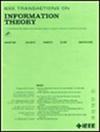Rate-Adaptive Protograph-Based MacKay-Neal Codes
IF 2.2
3区 计算机科学
Q3 COMPUTER SCIENCE, INFORMATION SYSTEMS
引用次数: 0
Abstract
Rate-adaptive MacKay-Neal (MN) codes based on protographs are analyzed. The code construction employs an outer distribution matcher (DM) to adapt the rate of the scheme. The DM is coupled with an inner protograph-based low-density parity-check (LDPC) code. The performance achievable by the resulting code structure, that is nonlinear, is studied by means of an equivalent communication model that reduces the problem to the analysis of the inner (linear) LDPC code with transmission that takes place in parallel over the communication channel, and over a suitably defined binary symmetric channel. A density evolution analysis of protograph MN code ensembles is outlined, and it is complemented by an error floor analysis that relies on the derivation of the average input-output weight distribution of the inner LDPC code ensemble. Conditions on the shape of the normalized logarithmic asymptotic input-output weight distribution are defined, which allow discarding code ensembles with bad error floor properties during the code design phase. Examples of code designs are provided, showing how the use of a single LDPC code ensemble allows operating within 1 dB from the Shannon limit over a wide range of code rates, where the code rate is selected by tuning the DM parameters. By enabling rate flexibility with a constant blocklength, and with a fixed LDPC code as inner code, the construction provides an appealing solution for very high-throughput wireless (optical) links that employ binary-input modulations.求助全文
约1分钟内获得全文
求助全文
来源期刊

IEEE Transactions on Information Theory
工程技术-工程:电子与电气
CiteScore
5.70
自引率
20.00%
发文量
514
审稿时长
12 months
期刊介绍:
The IEEE Transactions on Information Theory is a journal that publishes theoretical and experimental papers concerned with the transmission, processing, and utilization of information. The boundaries of acceptable subject matter are intentionally not sharply delimited. Rather, it is hoped that as the focus of research activity changes, a flexible policy will permit this Transactions to follow suit. Current appropriate topics are best reflected by recent Tables of Contents; they are summarized in the titles of editorial areas that appear on the inside front cover.
 求助内容:
求助内容: 应助结果提醒方式:
应助结果提醒方式:


